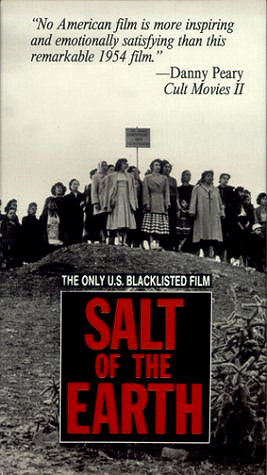
We all know that Hollywood has made a number of films in New Mexico. But one film that gained the kind of notoriety that chambers of commerce don’t appreciate, was Salt of the Earth, an independent film produced by Paul Jarrico and directed by Herbert Biberman, released sixty years ago on March 14, 1954.
The film was shot in Bayard and Silver City and the script depicts an actual strike against the Empire Zinc Mine in Grant County in 1950. Many miners were recruited to play themselves in the film.
Biberman was one of the Hollywood Ten, along with Dalton Trumbo and John Howard Lawson, and others, filmmakers who had been accused of being “pinkos” and included on a “blacklist”—thus denied work in the industry.
The 94-minute monochrome film is simple yet unrelenting in pursuit of the issues. A group of miners in Zinc Town, NM—both Anglos and Hispanos—go on strike for improved safety conditions—something miners still fight for—and for an end to the prejudice against Mexican American workers, who demand wage parity with Anglos. The company, with the aid of the local police and the courts, tries to break the strike.
When issued an injunction to end the strike, it looks like they’re finished; but ignoring their husband’s wishes, the wives and children take up the strike and the men are forced to change places and perform domestic duties. Eventually the company gives in, proposing higher wages and benefits. The men, however, are forced to confront not only their position with the bosses, but to re-evaluate their family relationships.
The message of women’s liberation comes across loud and clear, especially because of the strong portrayal of the leading man’s wife, by the great Mexican actor, Rosaura Revueltas. (Our government deported her to Mexico before the film was finished.) The strike is won because of solidarity, which was the old communist mantra; the Women’s Lib message was also a tenet of radical thinking going back 50 years, it was just ahead of 1960s popular culture.
I don’t know what affect this film had on unions or mining culture, or on New Mexico, and who knows how many people saw it, seeing as the government and the industry did everything they could to derail its distribution. (It was the only film banned in this country.)
But what’s still impressive after all these years, is that “Salt of the Earth” is a film about workers. A review on the Canadian Broadcasting System sums up with few exceptions American cinema: “Salt of the Earth is an American movie about workers, which fact alone makes it unusual. The idea that workers are people and have conflicts and problems worthy of attention, has never impressed the American film industry…”
Forget about Arnold and the Lone Ranger and his sidekick, at a time when 50 million Americans live in poverty, at a time when working families are suffering, unions are declining, and workers’ wages are stagnant, one wonders where the Bibermans and Trumbos of today are hiding out.



Responses to “Searching for today’s “Salt of the Earth””